Shahee Sansad
Shahee Sansasd शाही संसद | |
|---|---|
| 20th Shahee Sansad | |
 | |
| Type | |
| Type | |
| Houses | Council of States House of Representatives |
| History | |
| Founded | October 17, 1946 |
| Preceded by | Satria Etrurianan Colonial Administration |
New session started | September 15, 2020 |
| Leadership | |
Krishan VII since April 1984 | |
Adyaksh | XX1 since February 2012 |
Speaker | Devki Modhwadia1 since September 2015 |
Leader of the Opposition | |
| Structure | |
| Seats | 750 Consisting of 250 Councillors and 500 Members of Parliament |
 | |
Council of States political groups |
|
 | |
House of Representatives political groups | |
Joint committees | See Joint Committees of the Shahee Sansad |
Length of term | 5 years, renewable (House of Representatives) |
| Elections | |
Council of States voting system | Via appointment |
House of Representatives voting system | First-past-the-post and party-list proportional representation |
House of Representatives first election | October 1946 |
House of Representatives last election | September 2020 |
House of Representatives next election | September 2025 |
| Motto | |
| "Sadbhaav mein, Satyanishtha se" Transl.: In Concord, With Integrity | |
| Meeting place | |
 | |
| The Sansad Bhavan, Government Hill, Kinadica | |
| Constitution | |
| Constitution of the Kingdom of Rajyaghar Standing Orders of the Shahee Sansad | |
| Footnotes | |
| 1 = Required to be independent by Standing Orders | |
The Parliament of Rajyaghar, officially called and commonly referred to as the Shahee Sansad, is the federal and supreme legislature of the Kingdom of Rajyaghar. A unicameral legislature, the Shahee Sansad is made up of a mixture of elected and appointed individuals who are known as Members of Parliament (MPs). As the head of all branches of the government, the Monarch has the exclusive power to summon, prorogue and dissolve the Shahee Sansad but by convention this is only done following the Monarch taking advice from the Prime Minister.
The Shahee Sansad, and wider rajyani government, is modelled off of the Northabbey model in which the executive government (the Central Union Government) finds its members from within the legislature (the Shahee Sansad). Whilst the Monarch is the one to appoint the Prime Minister, by convention, the political party or coalition that holds a majority of seats in the Shahee Sansad, will nominate its leader to be the Prime Minister and will choose from amongst itself members who will serve in the Central Union Government. Due to the government of the day being required to have the support of a majority in the Shahee Sansad, it is not unusual for their to be early elections if they lose this support.
Of the 450 Members of Parliament, 260 are directly elected by the Rajyani electorate voting in single-member districts in a first-past-the-post system. 78 MPs are appointed by the Monarch on the advice given by an independent advisory board and an additional 112 are appointed based on their positions as heads of the 112 registered Clans of Rajyaghar. Due to this makeup, Rajyaghar is often considered a southern democracy or flawed democracy.
The Parliament meets at the Sansad Bhavan in Government Hill, Kinadica.
History
Parliamentary Complex
Sansad Bhavan
Sangh Bhavan
Composition
Sansad ke Sadasy is the official name given to members of the Shahee Sansad, abbreviated as SS and used as a suffix. Commonly, Sansad ke Sadasy are referred to via the estmerish translation of the name; Member of Parliament (abbrv. MP).
The Shahee Sansad is made up of 450 members which belong to one of three 'classes', all being called Members of Parliament.
- Class 1 - Directly elected, single member constituency representatives (260)
- Class 2 - Monarch-appointed individuals (78)
- Class 3 - Registered clan leaders (112)
Class 1 members are directly elected by the electorate via a first-past-the-post voting system in electoral districts named constituencies. These constituencies are represented by only one class 1 Member of Parliament and the borders of the constituencies are drawn up by the Independent Boundary Commission (IBC), a non-partisan public body. Class 1 members are elected every 5 years, or earlier, at the general election and are not term limited.
Class 2 members are appointed by the Monarch on the advice of the Independent Royal Appointments Commission (IRAC), a non-partisan public body which also provides the Monarch wtih advice regarding the appointment of ambassadors, chief civil servants and other positions. Class 2 members are first appointed for a term of 12 years and can then be reappointed for additional, renewable 6 year terms. Class 2 members must retire at age 75.
Class 3 members are the leaders of registered clans with the Ministry of Clan and Local Affairs (MCLA). At present, there are 112 registered clans. If more clans are recognised by the MCLA, then the number of Class 3 members increases at the expense of Class 2 membership as when class 2 members conclude their term they will not be invited to return. Class 3 members serve for as long as they are leaders of their clans. Leadership of clans is an internal clan affair but their leadership process must be uniform and recorded by the MCLA.
Upon dissolution of Parliament, all 3 classes lose membership within the Shahee Sansad. However, upon its return, previous class 2 and class 3 members are automatically reinstated with their terms continuing on and not restarting. Due to the partisan nature of the Shahee Sansad, class 2 and 3 members will often align themselves with a political party in order to obtain key positions on parliamentary committees. Class 3 members will often join the political party to which most of their clan belong.
Speaker of the House
The Constitution of Rajyaghar dictates that the Shahee Sansad must have a Speaker and at least two Deputy Speakers to preside over sessions of the Parliament. As per the Constitution, the Speaker and Deputy Speakers, must be elected by a simple majority of members present aand voting in the Parliament. Other than being Members of Parliament, the Constitution does not set out any specific qualifications for being elected Speaker. However, the Standing Orders of the Shahee Sansad dictate that the Speaker and Deputy Speakers must be elected from class 1 members of parliament and that the Speaker must resign their political party membership when they become Speaker in order to be independent and non-partisan. Due to the impartiality of the Speaker, there is an unwritten convention that political parties will not contest the election of the Speaker's constituency so as to allow them to run unopposed.
The Speaker is both a member and presiding officer of the Shahee Sansad and conducts regular business in the Parliament. However, the Speaker does not vote except on those rare occasions when there is a tie at the end of a decision. In the event of resignation, death or removal, the senior Deputy Speaker shall become Acting Speaker of the Shahee Sansad and a new election for Speaker will take place. Speakers and Deputy Speakers can be removed by the Shahee Sansad through a vote of no confidence with 2/3rds of the House being required to vote in favour of removal. If no Deputy Speakers are available, the Monarch will appoint an acting-Speaker.
In the 20th Shahee Sansad, Devki Modhwadia is the current Speaker. Mr. Modhwadia has served as Speaker since the opening of the 19th Shahee Sansad in September 2015.
Parliamentary Leadership
The parliamentary leadership of the Shahee Sansad can be split into functional leadership and party political leadership. The functional leadership consists of the Speaker and Deputy Speakers with the party political leadership consisting of the parliamentary leaders of the political parties. Each political party typically has the following parliamentary leadership:
| Party Political Leadership Position | Position if in Government | Position if in the official opposition |
|---|---|---|
| Party Leader | Prime Minister | Leader of the Opposition |
| Deputy Party Leader | Senior Secretary of State | Senior Shadow Secretary of State |
| Caucus Leader1 | Leader of the House | Shadow Leader of the House |
| Chief Whip | Government Chief Whip | Opposition Chief Whip |
The order of precedence within the Shahee Sansad is as follows:
- Speaker of the House
- Deputy Speakers (x2)
- Premier of Rajyaghar
- Cabinet Ministers
- Opposition Party Leaders (by parliamentary party size)
- Members of Parliament (by length of service)
Powers and Duties
Legislative Function
Executive Function
Judicial Function
Sessions of Parliament
State Opening of the Shahee Sansad
Legislative Procedure
Privileges
References
1 = Caucus leader is often merged with Party Leader for political parties which are neither the Governing or Official Opposition parties.

